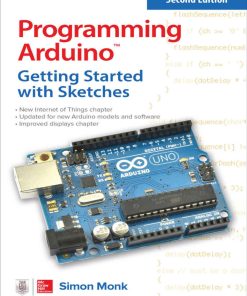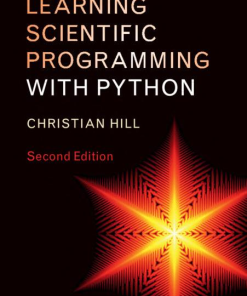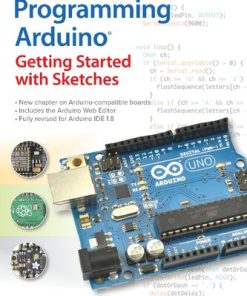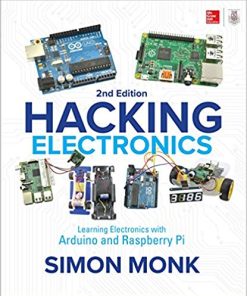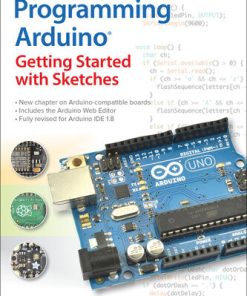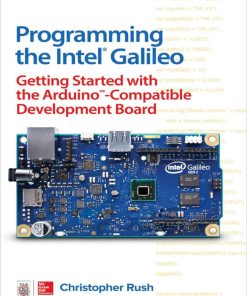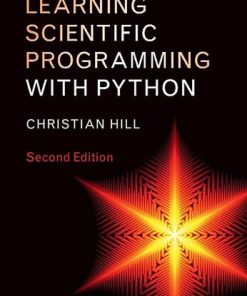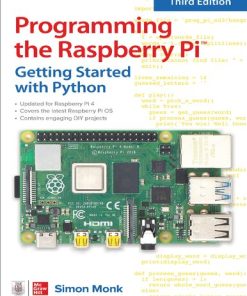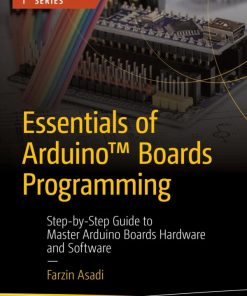(EBOOK PDF)Programming Arduino Next Steps Going Further with Sketches 2nd Edition by Simon Monk 9781260143256 1260143252 full chapters
$50.00 Original price was: $50.00.$25.00Current price is: $25.00.
Programming Arduino Next Steps Going Further with Sketches 2nd Edition by Simon Monk – Ebook PDF Instant Download/Delivery: 9781260143256, 1260143252
Full download Programming Arduino Next Steps Going Further with Sketches 2nd Edition after payment
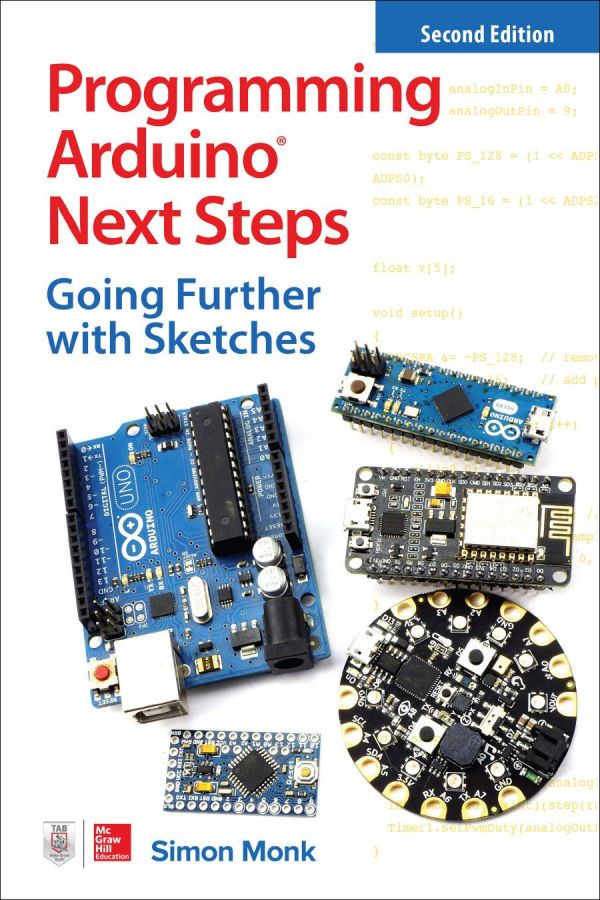
Product details:
• ISBN 10:1260143252
• ISBN 13:9781260143256
• Author:Simon Monk
Programming Arduino Next Steps: Going Further with Sketches, Second Edition
Go beyond the basics with this up to date Arduino programming resource Take your Arduino programming skills to the next level using the hands-on information contained in this thoroughly revised, easy to follow TAB guide. Aimed at programmers and hobbyists who have mastered the fundamentals, Programming Arduino Next Steps: Going Further with Sketches, Second Edition reveals professional programming tips and tricks. This up-to-date edition covers the Internet of Things (IoT) and features new chapters on interfacing your Arduino with other microcontrollers. You will get dozens of illustrated examples and downloadable code examples that clearly demonstrate each powerful technique. Discover how to: •Configure your Arduino IDE and develop your own sketches •Boost performance and speed by writing time-efficient sketches •Optimize power consumption and memory usage •Interface with different types of serial busses, including I2C, 1-Wire, SPI, and TTL Serial •Use Arduino with USB and UART •Incorporate Ethernet, Bluetooth, and DSP •Program Arduino for the Internet •Manage your sketches using One Process •Accomplish more than one task at a time―without multi-threading •Create your own code library and share it with other hobbyists
Programming Arduino Next Steps Going Further with Sketches 2nd Table of contents:
1 Programming Arduino
What Is Arduino?
Installation and the IDE
Installing the IDE
Blink
A Tour of Arduino
Power Supply
Power Connections
Analog Inputs
Digital Connections
Arduino Boards
Uno and Similar
Big Arduino Boards
Small Arduino Boards
Unofficial Arduinos
Programming Language
Modifying the Blink Sketch
Variables
If
Loops
Functions
Digital Inputs
Digital Outputs
The Serial Monitor
Arrays and Strings
Analog Inputs
Analog Outputs
Using Libraries
Arduino Data Types
Arduino Commands
Summary
2 Under the Hood
A Brief History of Arduino
Anatomy of an Arduino
AVR Processors
ATmega328
ATmega32u4
ATmega2560
AT91SAM3X8E
Arduino and Wiring
From Sketch to Arduino
AVR Studio
Installing a Bootloader
Burning a Bootloader with AVR Studio and a Programmer
Burning a Bootloader with the Arduino IDE and a Second Arduino
Summary
3 When Is an Arduino Not an Arduino?
The Arduino IDE’s Extensible Architecture
Adafruit Circuit Playground Express
NodeMCU
ESP32
ATtiny Microcontrollers
ATtiny44
Using an Arduino as a Programmer
Installing ATtinyCore into the IDE
Clocks, Crystals, and Fuses
Minimal Arduino
Summary
4 Interrupts and Timers
Hardware Interrupts
Interrupt Pins
Interrupt Modes
Enabling Internal Pull-Up
Interrupt Service Routines
Volatile Variables
ISR Summary
Enabling and Disabling Interrupts
Timer Interrupts
Summary
5 Making Arduino Faster
How Fast Is an Arduino?
Comparing Arduino Boards
Speeding Up Arithmetic
Do You Really Need to Use a Float?
Lookup vs. Calculate
Fast I/O
Basic Code Optimization
Bytes and Bits
ATmega328 Ports
Very Fast Digital Output
Fast Digital Input
Speeding Up Analog Inputs
Summary
6 Low-Power Arduino
Power Consumption of Arduino Boards
Current and Batteries
Reducing the Clock Speed
Turning Things Off
Sleeping ATmega-Based Arduinos
Narcoleptic
Waking ATmega-Based Arduinos on External Interrupts
ESP8266 Sleeping
ESP32 Sleeping
Use Digital Outputs to Control Power
Summary
7 Memory
Arduino Memory
Minimizing RAM Usage
Use the Right Data Structures
Store String Constants in Flash Memory
Common Misconceptions
Measure Free Memory
Minimizing Flash Usage
Use Constants
Remove Unwanted Trace
Bypass the Bootloader
Static vs. Dynamic Memory Allocation
Strings
C char Arrays
The Arduino String Object Library
Using EEPROM
EEPROM Example
Using the avr/eeprom.h Library
EEPROM Limitations
Using Flash
Using SD Card Storage
Summary
8 Interfacing with Arduino
Binary
Arduino Types and Binary
Hexadecimal
Masking Bits
Shifting Bits
Serial Data
Summary
9 Using I2C
I2C Hardware
The I2C Protocol
The Wire Library
Initializing I2C
Master Sending Data
Master Receiving Data
I2C Examples
TEA5767 FM Radio
Arduino-to-Arduino Communication
LED Backpack Boards
DS1307 Real-Time Clock
Summary
10 Interfacing with 1-Wire Devices
1-Wire Hardware
The 1-Wire Protocol
The OneWire Library
Initializing 1-Wire
Scanning the Bus
Using the DS18B20
Summary
11 Interfacing with SPI Devices
Bit Manipulation
SPI Hardware
The SPI Protocol
The SPI Library
SPI Example
Summary
12 Serial UART Programming
Serial Hardware
Serial Protocol
The Serial Commands
The SoftwareSerial Library
Serial Examples
Computer to Arduino over USB
Arduino to Arduino
GPS Module
Summary
13 USB Programming
Keyboard and Mouse Emulation
Keyboard Emulation
Keyboard Emulation Example
Mouse Emulation
Mouse Emulation Example
USB Host on the Arduino Due
Summary
14 Network and Internet of Things Programming
Networking Hardware
Ethernet Shield
Arduino Ethernet/EtherTen
The Ethernet Library
Making a Connection
Setting Up a Web Server
Making Requests
Wired Ethernet Examples
Physical Web Server
Using a JSON Web Service
The Official Arduino WiFi Library
Making a Connection
WiFi-Specific Functions
Arduino WiFi Example
ESP8266/ESP32 WiFi Example
Internet of Things
dweet.io
Programming the NodeMCU or Wemos D1 Mini
Attaching the TMP36
A Web Page to Display the Temperature
Summary
15 Digital Signal Processing
Introducing Digital Signal Processing
Averaging Readings
An Introduction to Filtering
Creating a Simple Low-Pass Filter
Arduino Uno DSP
Arduino Due DSP
Filter Code Generation
The Fourier Transform
Spectrum Analyzer Example
Frequency Measurement Example
Summary
16 Managing with One Process
Making the Transition from Big Programming
Why You Don’t Need Threads
Setup and Loop
Sense Then Act
Pause Without Blocking
The Timer Library
State Diagrams
State Machines in Arduino
Summary
17 Writing Libraries
When to Make a Library
Using Classes and Methods
Library Example (TEA5767 Radio)
Define the Library’s Interface
Write the Header File
Write the Implementation File
Write the Keywords File
Make the Examples Folder
Testing the Library
Releasing the Library
Publishing Your Library on GitHub
GitHub
Creating a Repository
Summary
A Parts
Arduino Boards
Components and Modules
Suppliers
Arduino Starter Kits
Index
People also search for Programming Arduino Next Steps Going Further with Sketches 2nd:
programming arduino next steps: going further
next steps for learning
programming stepper motor arduino
how to stop arduino program from running
programming arduino for beginners
Tags:
Programming Arduino,Going Further,Simon Monk
You may also like…
Computers - Programming
Programming Arduino: Getting Started with Sketches (Tab) 2nd Edition
Computers - Programming
Learning Scientific Programming With Python 2nd Edition Christian Hill
Uncategorized
Computers - Programming
Engineering - Electrical & Electronic Engineering


